Demanding an immediate end to the war in Iraq, tens of thousands of people marched in cities around the world or demonstrated outside US military bases, but the demonstrations were far smaller than recent protests.
"Bush, murderer," chanted protesters in Paris Saturday, while protesters in Helsinki, Finland roared, "George Bush, CIA, how many kids did you kill today?"
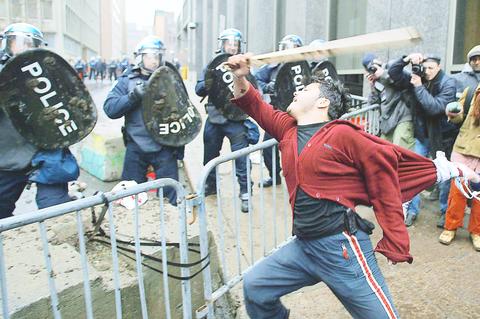
PHOTO: AP
Organizers said there had not been much time to plan protests, but there was little sign of people responding to calls to pour into the streets or responding spontaneously to the start of war. Despite large turnouts in some cities Saturday, the mostly peaceful marches were dwarfed by anti-war protests Feb. 15, which saw some of the largest demonstrations in history.
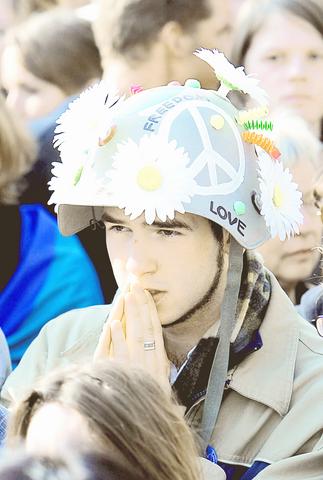
PHOTO: AP
In the African nation of Sudan, anti-riot police reportedly shot dead a 19-year-old university student during a protest in the capital, Khartoum, his cousin said. Police were not immediately available for comment.
Jaakko Kartano, a student at a march in Helsinki, Finland, said, "People ask what's the use of this, but our task is to instill faith in people and try and prevent anything like it [the war] happening again."
There was a sense of frustration among marchers in London. The turnout was well down from last month's mass rally, which drew at least 750,000 people, with police estimating turnout Saturday at 200,000.
Many protesters said they did not expect British Prime Minister Tony Blair or US President George W. Bush to listen to them.
"I don't think there is a snowball's chance in hell this march will stop the war but it's going to send out a message to next time, maybe," said Ernie Vandermass, a student who marched in London.
Protests would grow as the war continued, organizers said.
In the US, anti-war activists marched in dozens of cities, marshaling well over 100,000 in Manhattan.
Tens of thousands protested in San Francisco after two days of anti-war rallies in which about 2,200 were arrested.
Supporters of the war marched too, often by the thousands, with American flags and chants of "USA!" An estimated 15,000 pro-military demonstrators crammed shoulder-to-shoulder, prayed, and sang patriotic songs in Auburn, Indiana.
In Europe there were dozens of demonstrations involving tens of thousands of people in Britain, France, Germany, Finland, Italy, Sweden, Norway, Denmark and other countries.
A few radicals scuffled with police on the fringes of some demonstrations and there were scattered arrests.
In the Spanish capital Madrid, police fired rubber bullets to disperse protesters for the second day running. In Barcelona, police said 150,000 protested, while town hall officials estimated up to half a million.
Dozens of protesters hurled rocks and paint at police who used tear gas and dogs to stop them from reaching the US embassy in Oslo, Norway.
About 90,000 people marched in Paris, police said. French protesters singled out the McDonald's fast food chain as a symbol of American influence, with protesters pelting rocks at a restaurant in Strasbourg and others bursting into a McDonald's in Lyon.
Police said 30,000 people marched in Bern, Switzerland, where organizers estimated between 40,000 and 50,000.
In Berlin, about 40,000 protested and one placard declared "Dresden 1945, Baghdad 2003: The same crime" -- a reference to the Allied firebombing of the eastern German city at the end of World War II.
In Asia, the largest demonstrations were in Indonesia, the world's most populous Islamic nation, but only a few thousand people took part, some burning US flags and photos of Bush.

MISINFORMATION: The generated content tends to adopt China’s official stance, such as ‘Taiwan is currently governed by the Chinese central government,’ the NSB said Five China-developed artificial intelligence (AI) language models exhibit cybersecurity risks and content biases, an inspection conducted by the National Security Bureau (NSB) showed. The five AI tools are: DeepSeek, Doubao (豆包), Yiyan (文心一言), Tongyi (通義千問) and Yuanbao (騰訊元寶), the bureau said, advising people to remain vigilant to protect personal data privacy and corporate business secrets. The NSB said it, in accordance with the National Intelligence Services Act (國家情報工作法), has reviewed international cybersecurity reports and intelligence, and coordinated with the Ministry of Justice Investigation Bureau and the National Police Agency’s Criminal Investigation Bureau to conduct an inspection of China-made AI language
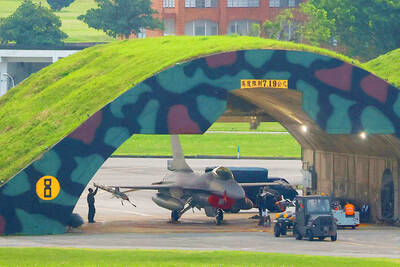
BOOST IN CONFIDENCE: The sale sends a clear message of support for Taiwan and dispels rumors that US President Donald Trump ‘sold out’ the nation, an expert said The US government on Thursday announced a possible sale to Taiwan of fighter jet parts, which was estimated to cost about US$330 million, in a move that an expert said “sends a clear message of support for Taiwan” amid fears that Washington might be wavering in its attitude toward Taipei. It was the first announcement of an arms sale to Taiwan since US President Donald Trump returned to the White House earlier this year. The proposed package includes non-standard components, spare and repair parts, consumables and accessories, as well repair and return support for the F-16, C-130 and Indigenous Defense Fighter aircraft,
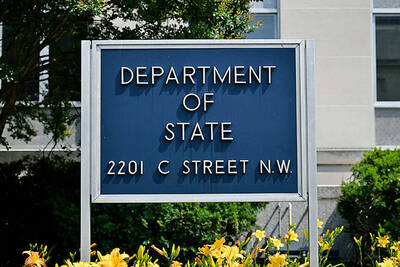
CHECKING BOUNDARIES: China wants to disrupt solidarity among democracies and test their red lines, but it is instead pushing nations to become more united, an expert said The US Department of State on Friday expressed deep concern over a Chinese public security agency’s investigation into Legislator Puma Shen (沈伯洋) for “secession.” “China’s actions threaten free speech and erode norms that have underpinned the cross-strait ‘status quo’ for decades,” a US Department of State spokesperson said. The Chongqing Municipal Public Security Bureau late last month listed Shen as “wanted” and launched an investigation into alleged “secession-related” criminal activities, including his founding of the Kuma Academy, a civil defense organization that prepares people for an invasion by China. The spokesperson said that the US was “deeply concerned” about the bureau investigating Shen
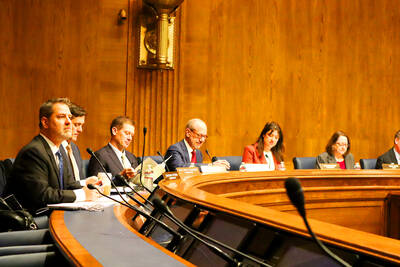
LIMITS: While China increases military pressure on Taiwan and expands its use of cognitive warfare, it is unwilling to target tech supply chains, the report said US and Taiwan military officials have warned that the Chinese People’s Liberation Army (PLA) could implement a blockade within “a matter of hours” and need only “minimal conversion time” prior to an attack on Taiwan, a report released on Tuesday by the US Senate’s China Economic and Security Review Commission said. “While there is no indication that China is planning an imminent attack, the United States and its allies and partners can no longer assume that a Taiwan contingency is a distant possibility for which they would have ample time to prepare,” it said. The commission made the comments in its annual